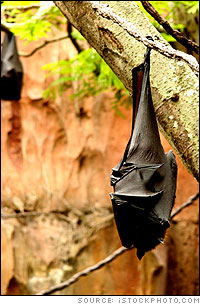Spotlight on Bats

Mysterious Mammals on the Fly
Source: U.S. Fish and Wildlife Service |
 ECHOLOCATIONAlthough bats have relatively good eyesight, most depend on their superbly developed echolocation (or sonar) system to navigate and capture insects in the dark. Bats emit pulses of very high-frequency sound (inaudible to human ears) at a rate of a few to 200 per second. By listening to the echoes reflected back to them, they can discern objects in their path. Their echolocation ability is so acute they can avoid obstacles no wider than a piece of thread and capture tiny flying insects even in complete darkness. In Our Encyclopedia |
Bats may be the most misunderstood animals in the United States. Almost all U.S. bats, and 70 percent of the bat species worldwide, feed almost exclusively on insects and are thus extremely beneficial. One bat can eat between 600 and 1,000 mosquitoes and other insect pests in just one hour.
Bats in other parts of the world feed on a variety of items in addition to insects. Many species feed primarily on fruit, while several types feed on nectar and pollen. Fruit bats perform an extremely important function as seed dispersers. Nectar-eating bats are important pollinators. Many plant species depend almost entirely on bats for pollination.
Of the 45 species of bats found in the continental United States, six are listed as endangered. These species are the gray bat, Indiana bat, Ozark big-eared bat, Virginia big-eared bat, lesser long-nosed bat, and greater Mexican long-nosed bat.







